Report: Identifying Entrepreneurial Opportunities for Down2Earth Ltd.
VerifiedAdded on 2023/01/12
|9
|2665
|45
Report
AI Summary
This report, prepared for Nescot College's Unit 27 on Identifying Entrepreneurial Opportunities, analyzes the business idea of Down2Earth Ltd., a company focused on eco-friendly products, and its potential for manufacturing sustainable bamboo cups. The report examines the sources of entrepreneurial ideas and innovation, referencing Peter Drucker's theory and providing examples. It then utilizes Porter's Five Forces analysis to assess the market gap and competitive landscape, followed by a SWOT analysis to evaluate the strengths, weaknesses, opportunities, and threats associated with the business idea. Furthermore, the report incorporates a PESTLE analysis to understand the broader market environment, including political, economic, social, and technological factors. The analysis aims to determine the viability and potential success of the entrepreneurial venture, providing a comprehensive evaluation of the business concept.
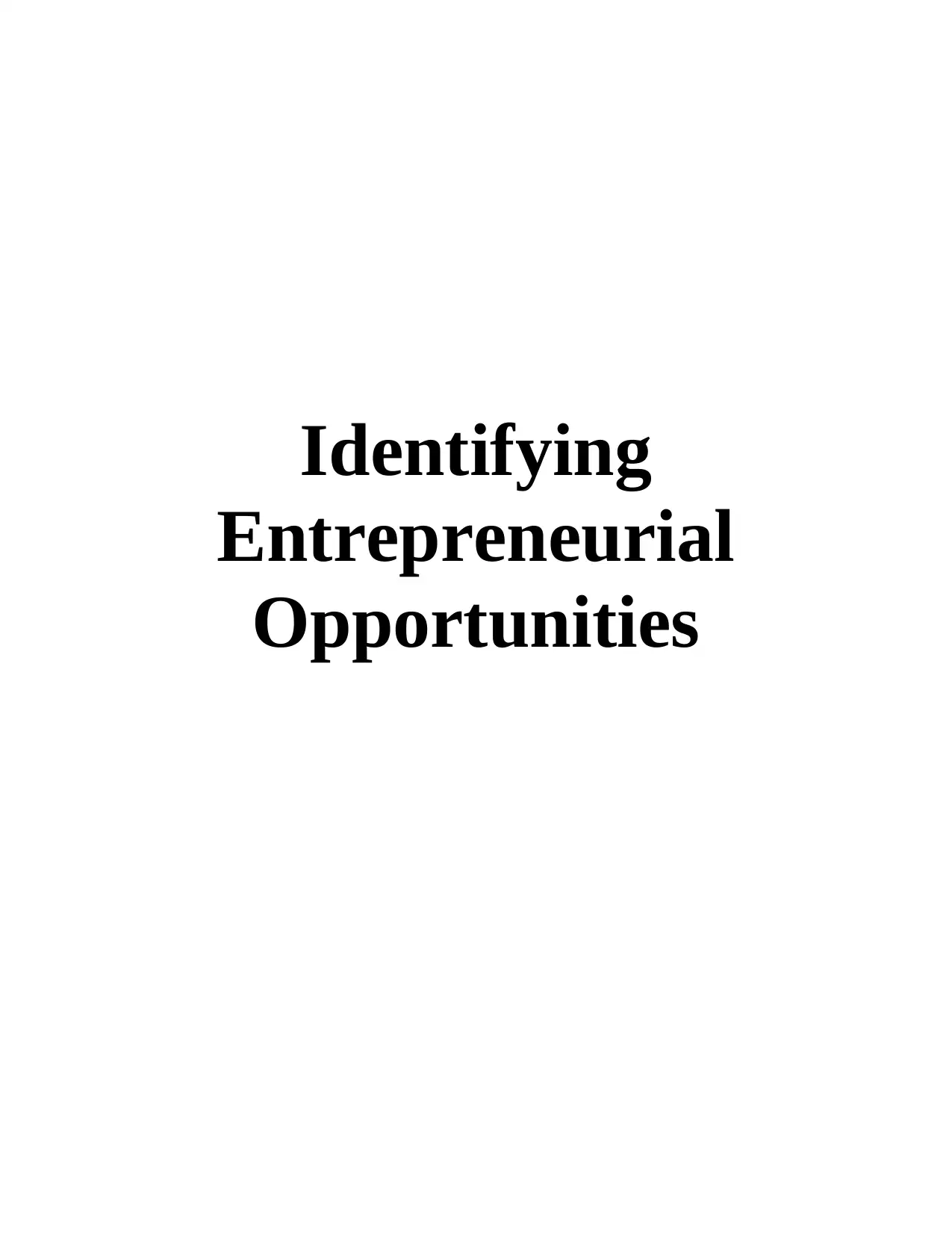
Identifying
Entrepreneurial
Opportunities
Entrepreneurial
Opportunities
Paraphrase This Document
Need a fresh take? Get an instant paraphrase of this document with our AI Paraphraser
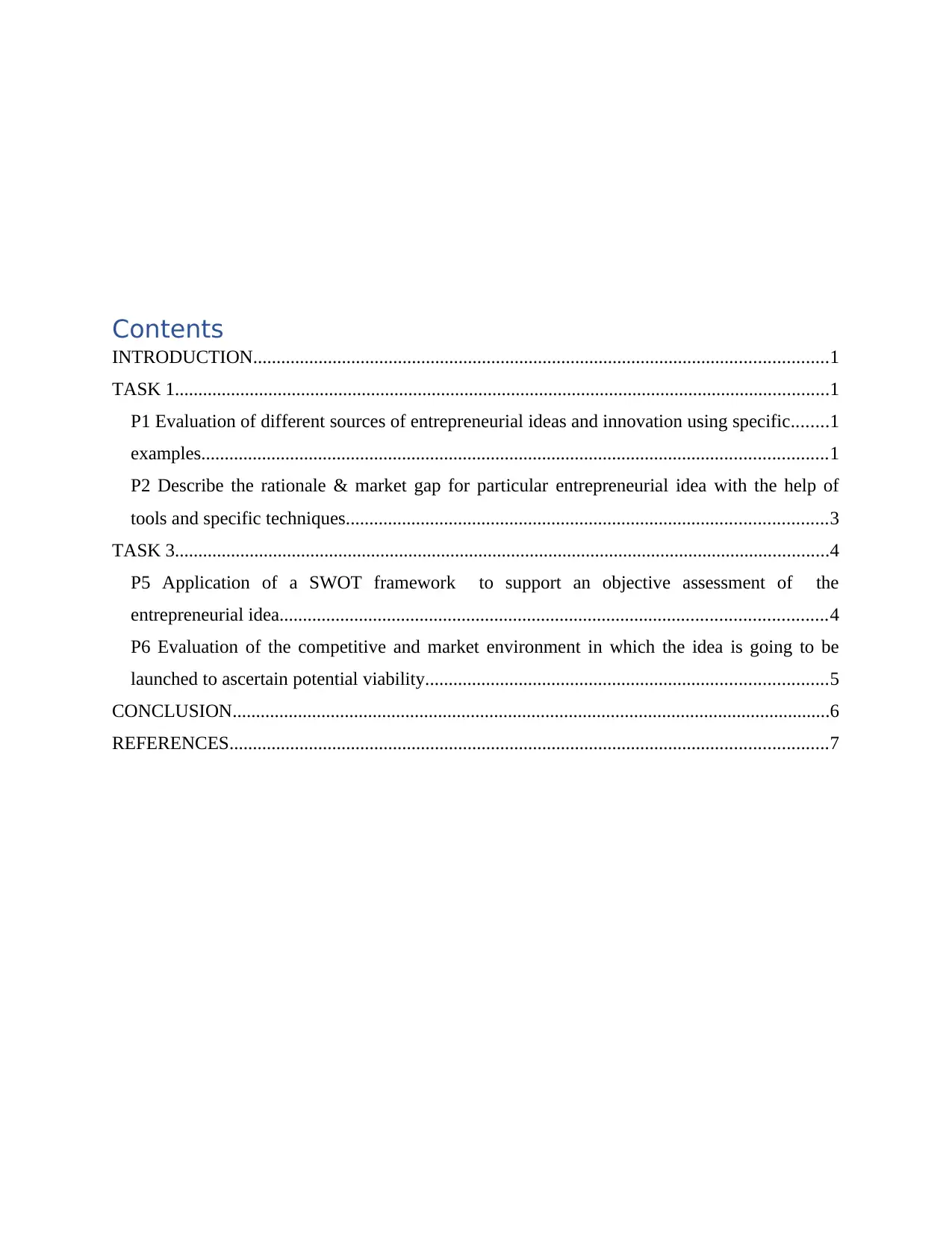
Contents
INTRODUCTION...........................................................................................................................1
TASK 1............................................................................................................................................1
P1 Evaluation of different sources of entrepreneurial ideas and innovation using specific........1
examples......................................................................................................................................1
P2 Describe the rationale & market gap for particular entrepreneurial idea with the help of
tools and specific techniques.......................................................................................................3
TASK 3............................................................................................................................................4
P5 Application of a SWOT framework to support an objective assessment of the
entrepreneurial idea.....................................................................................................................4
P6 Evaluation of the competitive and market environment in which the idea is going to be
launched to ascertain potential viability......................................................................................5
CONCLUSION................................................................................................................................6
REFERENCES................................................................................................................................7
INTRODUCTION...........................................................................................................................1
TASK 1............................................................................................................................................1
P1 Evaluation of different sources of entrepreneurial ideas and innovation using specific........1
examples......................................................................................................................................1
P2 Describe the rationale & market gap for particular entrepreneurial idea with the help of
tools and specific techniques.......................................................................................................3
TASK 3............................................................................................................................................4
P5 Application of a SWOT framework to support an objective assessment of the
entrepreneurial idea.....................................................................................................................4
P6 Evaluation of the competitive and market environment in which the idea is going to be
launched to ascertain potential viability......................................................................................5
CONCLUSION................................................................................................................................6
REFERENCES................................................................................................................................7
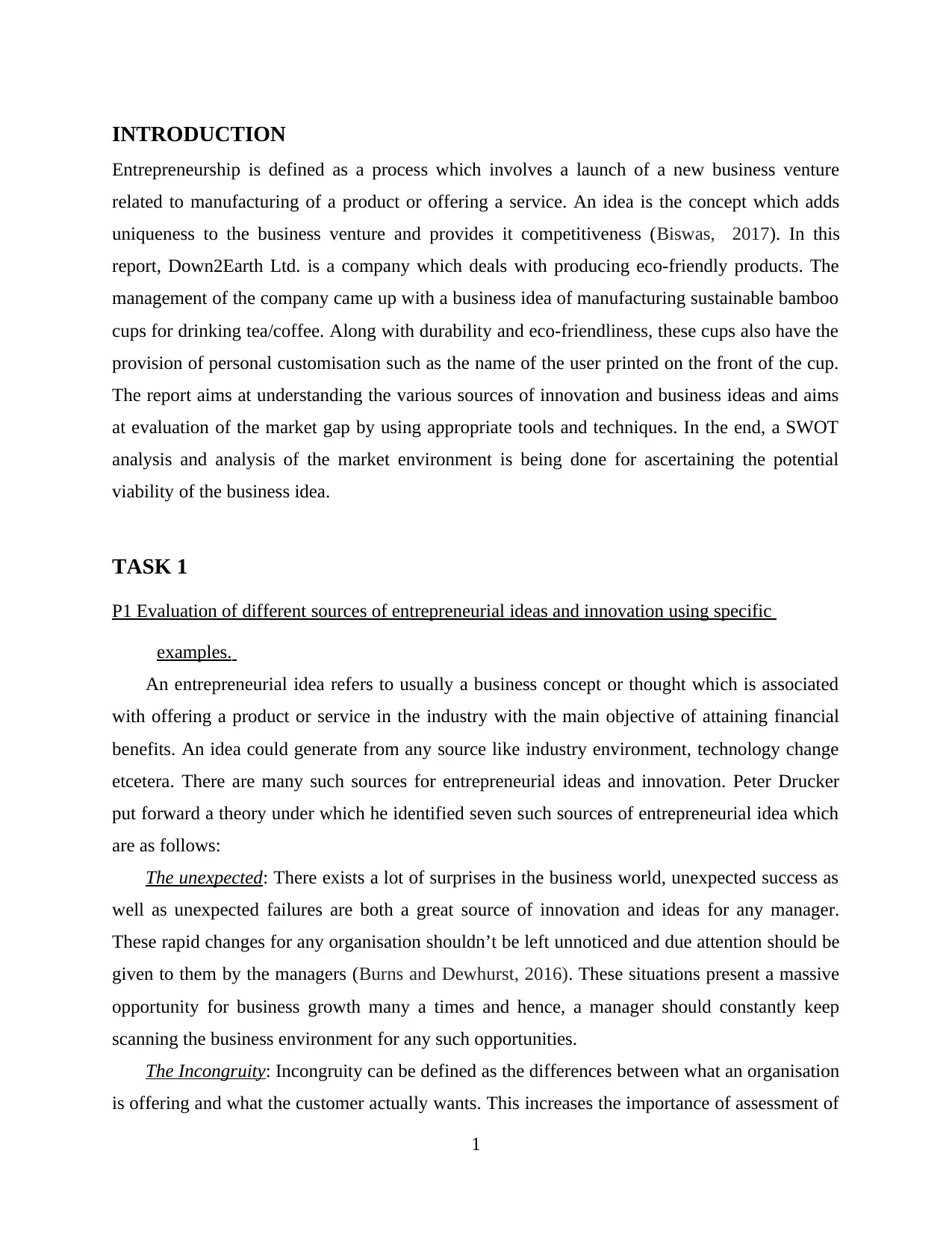
INTRODUCTION
Entrepreneurship is defined as a process which involves a launch of a new business venture
related to manufacturing of a product or offering a service. An idea is the concept which adds
uniqueness to the business venture and provides it competitiveness (Biswas, 2017). In this
report, Down2Earth Ltd. is a company which deals with producing eco-friendly products. The
management of the company came up with a business idea of manufacturing sustainable bamboo
cups for drinking tea/coffee. Along with durability and eco-friendliness, these cups also have the
provision of personal customisation such as the name of the user printed on the front of the cup.
The report aims at understanding the various sources of innovation and business ideas and aims
at evaluation of the market gap by using appropriate tools and techniques. In the end, a SWOT
analysis and analysis of the market environment is being done for ascertaining the potential
viability of the business idea.
TASK 1
P1 Evaluation of different sources of entrepreneurial ideas and innovation using specific
examples.
An entrepreneurial idea refers to usually a business concept or thought which is associated
with offering a product or service in the industry with the main objective of attaining financial
benefits. An idea could generate from any source like industry environment, technology change
etcetera. There are many such sources for entrepreneurial ideas and innovation. Peter Drucker
put forward a theory under which he identified seven such sources of entrepreneurial idea which
are as follows:
The unexpected: There exists a lot of surprises in the business world, unexpected success as
well as unexpected failures are both a great source of innovation and ideas for any manager.
These rapid changes for any organisation shouldn’t be left unnoticed and due attention should be
given to them by the managers (Burns and Dewhurst, 2016). These situations present a massive
opportunity for business growth many a times and hence, a manager should constantly keep
scanning the business environment for any such opportunities.
The Incongruity: Incongruity can be defined as the differences between what an organisation
is offering and what the customer actually wants. This increases the importance of assessment of
1
Entrepreneurship is defined as a process which involves a launch of a new business venture
related to manufacturing of a product or offering a service. An idea is the concept which adds
uniqueness to the business venture and provides it competitiveness (Biswas, 2017). In this
report, Down2Earth Ltd. is a company which deals with producing eco-friendly products. The
management of the company came up with a business idea of manufacturing sustainable bamboo
cups for drinking tea/coffee. Along with durability and eco-friendliness, these cups also have the
provision of personal customisation such as the name of the user printed on the front of the cup.
The report aims at understanding the various sources of innovation and business ideas and aims
at evaluation of the market gap by using appropriate tools and techniques. In the end, a SWOT
analysis and analysis of the market environment is being done for ascertaining the potential
viability of the business idea.
TASK 1
P1 Evaluation of different sources of entrepreneurial ideas and innovation using specific
examples.
An entrepreneurial idea refers to usually a business concept or thought which is associated
with offering a product or service in the industry with the main objective of attaining financial
benefits. An idea could generate from any source like industry environment, technology change
etcetera. There are many such sources for entrepreneurial ideas and innovation. Peter Drucker
put forward a theory under which he identified seven such sources of entrepreneurial idea which
are as follows:
The unexpected: There exists a lot of surprises in the business world, unexpected success as
well as unexpected failures are both a great source of innovation and ideas for any manager.
These rapid changes for any organisation shouldn’t be left unnoticed and due attention should be
given to them by the managers (Burns and Dewhurst, 2016). These situations present a massive
opportunity for business growth many a times and hence, a manager should constantly keep
scanning the business environment for any such opportunities.
The Incongruity: Incongruity can be defined as the differences between what an organisation
is offering and what the customer actually wants. This increases the importance of assessment of
1
⊘ This is a preview!⊘
Do you want full access?
Subscribe today to unlock all pages.

Trusted by 1+ million students worldwide
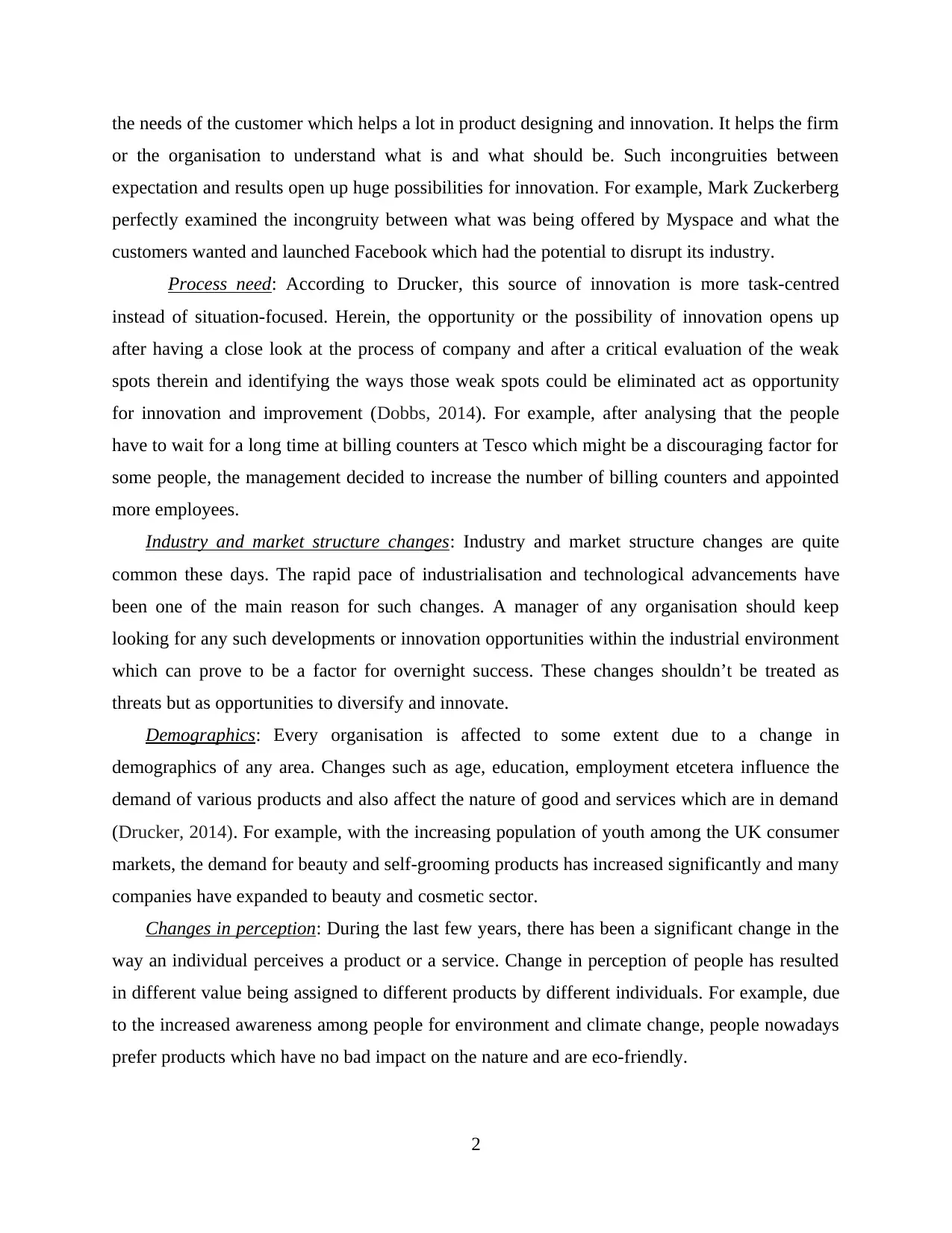
the needs of the customer which helps a lot in product designing and innovation. It helps the firm
or the organisation to understand what is and what should be. Such incongruities between
expectation and results open up huge possibilities for innovation. For example, Mark Zuckerberg
perfectly examined the incongruity between what was being offered by Myspace and what the
customers wanted and launched Facebook which had the potential to disrupt its industry.
Process need: According to Drucker, this source of innovation is more task-centred
instead of situation-focused. Herein, the opportunity or the possibility of innovation opens up
after having a close look at the process of company and after a critical evaluation of the weak
spots therein and identifying the ways those weak spots could be eliminated act as opportunity
for innovation and improvement (Dobbs, 2014). For example, after analysing that the people
have to wait for a long time at billing counters at Tesco which might be a discouraging factor for
some people, the management decided to increase the number of billing counters and appointed
more employees.
Industry and market structure changes: Industry and market structure changes are quite
common these days. The rapid pace of industrialisation and technological advancements have
been one of the main reason for such changes. A manager of any organisation should keep
looking for any such developments or innovation opportunities within the industrial environment
which can prove to be a factor for overnight success. These changes shouldn’t be treated as
threats but as opportunities to diversify and innovate.
Demographics: Every organisation is affected to some extent due to a change in
demographics of any area. Changes such as age, education, employment etcetera influence the
demand of various products and also affect the nature of good and services which are in demand
(Drucker, 2014). For example, with the increasing population of youth among the UK consumer
markets, the demand for beauty and self-grooming products has increased significantly and many
companies have expanded to beauty and cosmetic sector.
Changes in perception: During the last few years, there has been a significant change in the
way an individual perceives a product or a service. Change in perception of people has resulted
in different value being assigned to different products by different individuals. For example, due
to the increased awareness among people for environment and climate change, people nowadays
prefer products which have no bad impact on the nature and are eco-friendly.
2
or the organisation to understand what is and what should be. Such incongruities between
expectation and results open up huge possibilities for innovation. For example, Mark Zuckerberg
perfectly examined the incongruity between what was being offered by Myspace and what the
customers wanted and launched Facebook which had the potential to disrupt its industry.
Process need: According to Drucker, this source of innovation is more task-centred
instead of situation-focused. Herein, the opportunity or the possibility of innovation opens up
after having a close look at the process of company and after a critical evaluation of the weak
spots therein and identifying the ways those weak spots could be eliminated act as opportunity
for innovation and improvement (Dobbs, 2014). For example, after analysing that the people
have to wait for a long time at billing counters at Tesco which might be a discouraging factor for
some people, the management decided to increase the number of billing counters and appointed
more employees.
Industry and market structure changes: Industry and market structure changes are quite
common these days. The rapid pace of industrialisation and technological advancements have
been one of the main reason for such changes. A manager of any organisation should keep
looking for any such developments or innovation opportunities within the industrial environment
which can prove to be a factor for overnight success. These changes shouldn’t be treated as
threats but as opportunities to diversify and innovate.
Demographics: Every organisation is affected to some extent due to a change in
demographics of any area. Changes such as age, education, employment etcetera influence the
demand of various products and also affect the nature of good and services which are in demand
(Drucker, 2014). For example, with the increasing population of youth among the UK consumer
markets, the demand for beauty and self-grooming products has increased significantly and many
companies have expanded to beauty and cosmetic sector.
Changes in perception: During the last few years, there has been a significant change in the
way an individual perceives a product or a service. Change in perception of people has resulted
in different value being assigned to different products by different individuals. For example, due
to the increased awareness among people for environment and climate change, people nowadays
prefer products which have no bad impact on the nature and are eco-friendly.
2
Paraphrase This Document
Need a fresh take? Get an instant paraphrase of this document with our AI Paraphraser
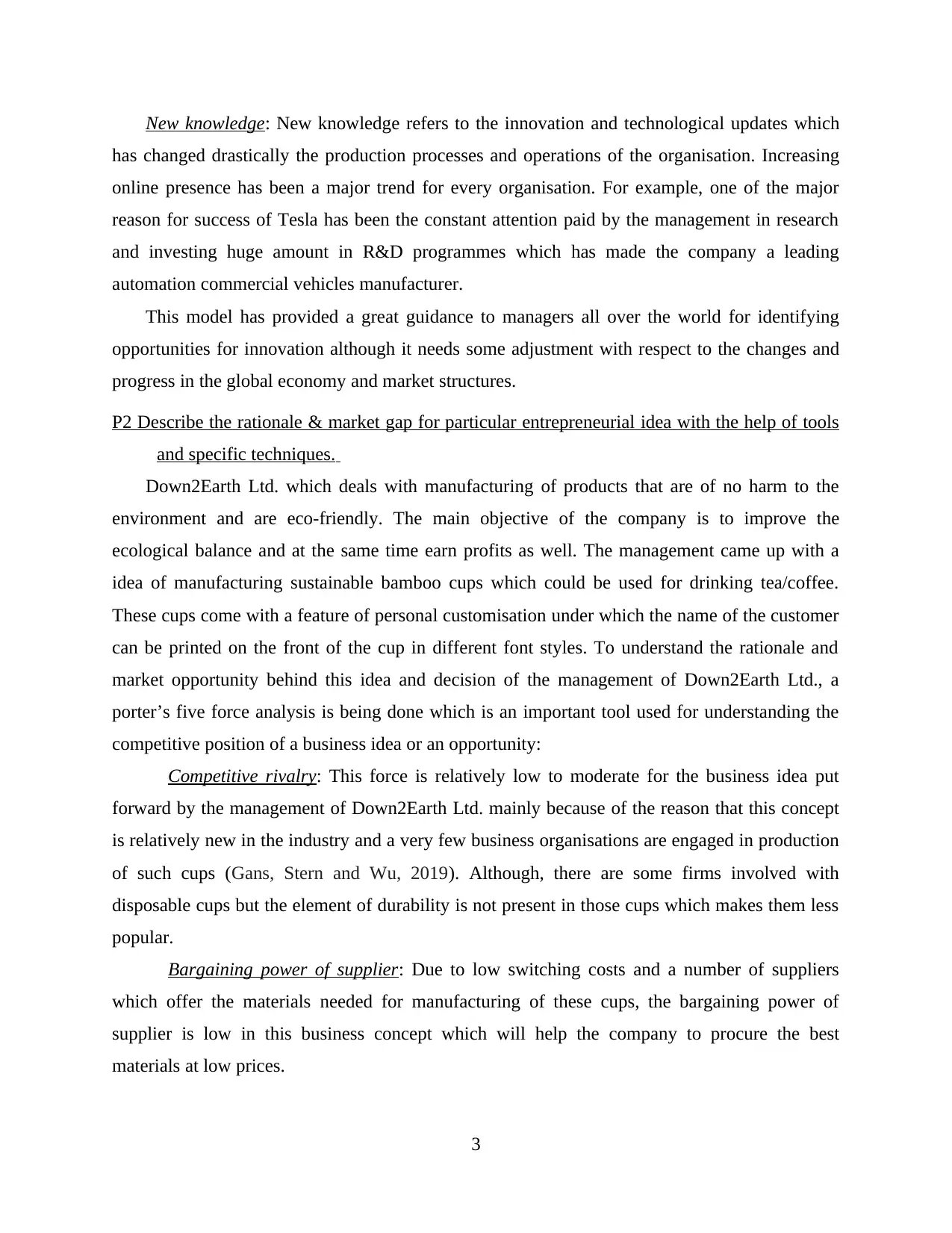
New knowledge: New knowledge refers to the innovation and technological updates which
has changed drastically the production processes and operations of the organisation. Increasing
online presence has been a major trend for every organisation. For example, one of the major
reason for success of Tesla has been the constant attention paid by the management in research
and investing huge amount in R&D programmes which has made the company a leading
automation commercial vehicles manufacturer.
This model has provided a great guidance to managers all over the world for identifying
opportunities for innovation although it needs some adjustment with respect to the changes and
progress in the global economy and market structures.
P2 Describe the rationale & market gap for particular entrepreneurial idea with the help of tools
and specific techniques.
Down2Earth Ltd. which deals with manufacturing of products that are of no harm to the
environment and are eco-friendly. The main objective of the company is to improve the
ecological balance and at the same time earn profits as well. The management came up with a
idea of manufacturing sustainable bamboo cups which could be used for drinking tea/coffee.
These cups come with a feature of personal customisation under which the name of the customer
can be printed on the front of the cup in different font styles. To understand the rationale and
market opportunity behind this idea and decision of the management of Down2Earth Ltd., a
porter’s five force analysis is being done which is an important tool used for understanding the
competitive position of a business idea or an opportunity:
Competitive rivalry: This force is relatively low to moderate for the business idea put
forward by the management of Down2Earth Ltd. mainly because of the reason that this concept
is relatively new in the industry and a very few business organisations are engaged in production
of such cups (Gans, Stern and Wu, 2019). Although, there are some firms involved with
disposable cups but the element of durability is not present in those cups which makes them less
popular.
Bargaining power of supplier: Due to low switching costs and a number of suppliers
which offer the materials needed for manufacturing of these cups, the bargaining power of
supplier is low in this business concept which will help the company to procure the best
materials at low prices.
3
has changed drastically the production processes and operations of the organisation. Increasing
online presence has been a major trend for every organisation. For example, one of the major
reason for success of Tesla has been the constant attention paid by the management in research
and investing huge amount in R&D programmes which has made the company a leading
automation commercial vehicles manufacturer.
This model has provided a great guidance to managers all over the world for identifying
opportunities for innovation although it needs some adjustment with respect to the changes and
progress in the global economy and market structures.
P2 Describe the rationale & market gap for particular entrepreneurial idea with the help of tools
and specific techniques.
Down2Earth Ltd. which deals with manufacturing of products that are of no harm to the
environment and are eco-friendly. The main objective of the company is to improve the
ecological balance and at the same time earn profits as well. The management came up with a
idea of manufacturing sustainable bamboo cups which could be used for drinking tea/coffee.
These cups come with a feature of personal customisation under which the name of the customer
can be printed on the front of the cup in different font styles. To understand the rationale and
market opportunity behind this idea and decision of the management of Down2Earth Ltd., a
porter’s five force analysis is being done which is an important tool used for understanding the
competitive position of a business idea or an opportunity:
Competitive rivalry: This force is relatively low to moderate for the business idea put
forward by the management of Down2Earth Ltd. mainly because of the reason that this concept
is relatively new in the industry and a very few business organisations are engaged in production
of such cups (Gans, Stern and Wu, 2019). Although, there are some firms involved with
disposable cups but the element of durability is not present in those cups which makes them less
popular.
Bargaining power of supplier: Due to low switching costs and a number of suppliers
which offer the materials needed for manufacturing of these cups, the bargaining power of
supplier is low in this business concept which will help the company to procure the best
materials at low prices.
3
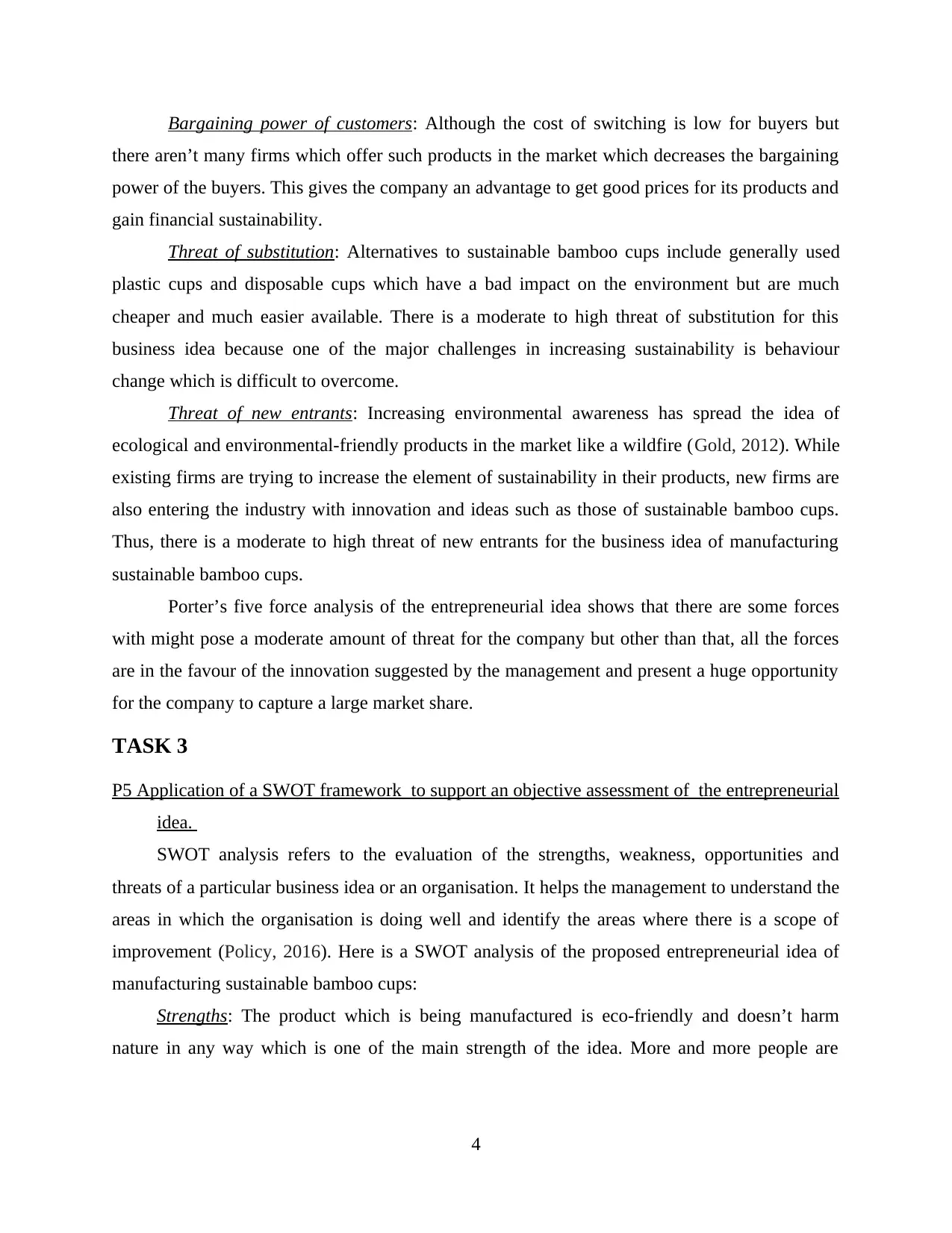
Bargaining power of customers: Although the cost of switching is low for buyers but
there aren’t many firms which offer such products in the market which decreases the bargaining
power of the buyers. This gives the company an advantage to get good prices for its products and
gain financial sustainability.
Threat of substitution: Alternatives to sustainable bamboo cups include generally used
plastic cups and disposable cups which have a bad impact on the environment but are much
cheaper and much easier available. There is a moderate to high threat of substitution for this
business idea because one of the major challenges in increasing sustainability is behaviour
change which is difficult to overcome.
Threat of new entrants: Increasing environmental awareness has spread the idea of
ecological and environmental-friendly products in the market like a wildfire (Gold, 2012). While
existing firms are trying to increase the element of sustainability in their products, new firms are
also entering the industry with innovation and ideas such as those of sustainable bamboo cups.
Thus, there is a moderate to high threat of new entrants for the business idea of manufacturing
sustainable bamboo cups.
Porter’s five force analysis of the entrepreneurial idea shows that there are some forces
with might pose a moderate amount of threat for the company but other than that, all the forces
are in the favour of the innovation suggested by the management and present a huge opportunity
for the company to capture a large market share.
TASK 3
P5 Application of a SWOT framework to support an objective assessment of the entrepreneurial
idea.
SWOT analysis refers to the evaluation of the strengths, weakness, opportunities and
threats of a particular business idea or an organisation. It helps the management to understand the
areas in which the organisation is doing well and identify the areas where there is a scope of
improvement (Policy, 2016). Here is a SWOT analysis of the proposed entrepreneurial idea of
manufacturing sustainable bamboo cups:
Strengths: The product which is being manufactured is eco-friendly and doesn’t harm
nature in any way which is one of the main strength of the idea. More and more people are
4
there aren’t many firms which offer such products in the market which decreases the bargaining
power of the buyers. This gives the company an advantage to get good prices for its products and
gain financial sustainability.
Threat of substitution: Alternatives to sustainable bamboo cups include generally used
plastic cups and disposable cups which have a bad impact on the environment but are much
cheaper and much easier available. There is a moderate to high threat of substitution for this
business idea because one of the major challenges in increasing sustainability is behaviour
change which is difficult to overcome.
Threat of new entrants: Increasing environmental awareness has spread the idea of
ecological and environmental-friendly products in the market like a wildfire (Gold, 2012). While
existing firms are trying to increase the element of sustainability in their products, new firms are
also entering the industry with innovation and ideas such as those of sustainable bamboo cups.
Thus, there is a moderate to high threat of new entrants for the business idea of manufacturing
sustainable bamboo cups.
Porter’s five force analysis of the entrepreneurial idea shows that there are some forces
with might pose a moderate amount of threat for the company but other than that, all the forces
are in the favour of the innovation suggested by the management and present a huge opportunity
for the company to capture a large market share.
TASK 3
P5 Application of a SWOT framework to support an objective assessment of the entrepreneurial
idea.
SWOT analysis refers to the evaluation of the strengths, weakness, opportunities and
threats of a particular business idea or an organisation. It helps the management to understand the
areas in which the organisation is doing well and identify the areas where there is a scope of
improvement (Policy, 2016). Here is a SWOT analysis of the proposed entrepreneurial idea of
manufacturing sustainable bamboo cups:
Strengths: The product which is being manufactured is eco-friendly and doesn’t harm
nature in any way which is one of the main strength of the idea. More and more people are
4
⊘ This is a preview!⊘
Do you want full access?
Subscribe today to unlock all pages.

Trusted by 1+ million students worldwide

becoming aware of the ecological imbalance which has created a demand for products with more
sustainability to which the product caters perfectly.
Weakness: People are less aware of such products and one of the most important challenge
is behaviour change which is very difficult to overcome. Another weakness might be the weak
distributional channels.
Opportunities: One of the major opportunity presented by the idea is the fact that there is a
great market potential for the product which has been proposed and there is no existing
competition in the industry so there is a great scope for getting an early lead in the industry and
gaining a good customer base at the very start.
Threats: Many companies are becoming aware of the environmental degradation and thus
plastic cups are being replaced by disposable cups which pose threat to the product which is
being proposed since they are relatively cheaper and are much easier to access.
P6 Evaluation of the competitive and market environment in which the idea is going to be
launched to ascertain potential viability.
Market environment refers to the macro-business environment which affects the operations of an
organisation but is outside the business control (Sarsby, 2016). A PESTLE analysis is being done
to understand the competitive and market environment of the area where idea is going to be
launched.
Political factors: It refers to the factors related with government intervention in the
country. Policies of government, liberal trade policies, labour laws etcetera. Government these
days is encouraging the companies who are engaged in manufacturing of goods that are better for
the environment and is offering various concessions. This is a great opportunity for the proposed
business idea to seek government support.
Economic factors: The rise in national income and employment opportunities has
encouraged the people to buy goods of better quality which are not harmful for the environment.
High-priced eco-friendly goods are being demanded by the people due to the increased
affordability.
Social factors: Social factors such as age of the population, preferences, taste etcetera
affect the type of goods and service which are in demand (Srdjevic, Bajcetic and Srdjevic, 2012).
An increasing youth population is a great opportunity for the company to gain popularity for its
5
sustainability to which the product caters perfectly.
Weakness: People are less aware of such products and one of the most important challenge
is behaviour change which is very difficult to overcome. Another weakness might be the weak
distributional channels.
Opportunities: One of the major opportunity presented by the idea is the fact that there is a
great market potential for the product which has been proposed and there is no existing
competition in the industry so there is a great scope for getting an early lead in the industry and
gaining a good customer base at the very start.
Threats: Many companies are becoming aware of the environmental degradation and thus
plastic cups are being replaced by disposable cups which pose threat to the product which is
being proposed since they are relatively cheaper and are much easier to access.
P6 Evaluation of the competitive and market environment in which the idea is going to be
launched to ascertain potential viability.
Market environment refers to the macro-business environment which affects the operations of an
organisation but is outside the business control (Sarsby, 2016). A PESTLE analysis is being done
to understand the competitive and market environment of the area where idea is going to be
launched.
Political factors: It refers to the factors related with government intervention in the
country. Policies of government, liberal trade policies, labour laws etcetera. Government these
days is encouraging the companies who are engaged in manufacturing of goods that are better for
the environment and is offering various concessions. This is a great opportunity for the proposed
business idea to seek government support.
Economic factors: The rise in national income and employment opportunities has
encouraged the people to buy goods of better quality which are not harmful for the environment.
High-priced eco-friendly goods are being demanded by the people due to the increased
affordability.
Social factors: Social factors such as age of the population, preferences, taste etcetera
affect the type of goods and service which are in demand (Srdjevic, Bajcetic and Srdjevic, 2012).
An increasing youth population is a great opportunity for the company to gain popularity for its
5
Paraphrase This Document
Need a fresh take? Get an instant paraphrase of this document with our AI Paraphraser
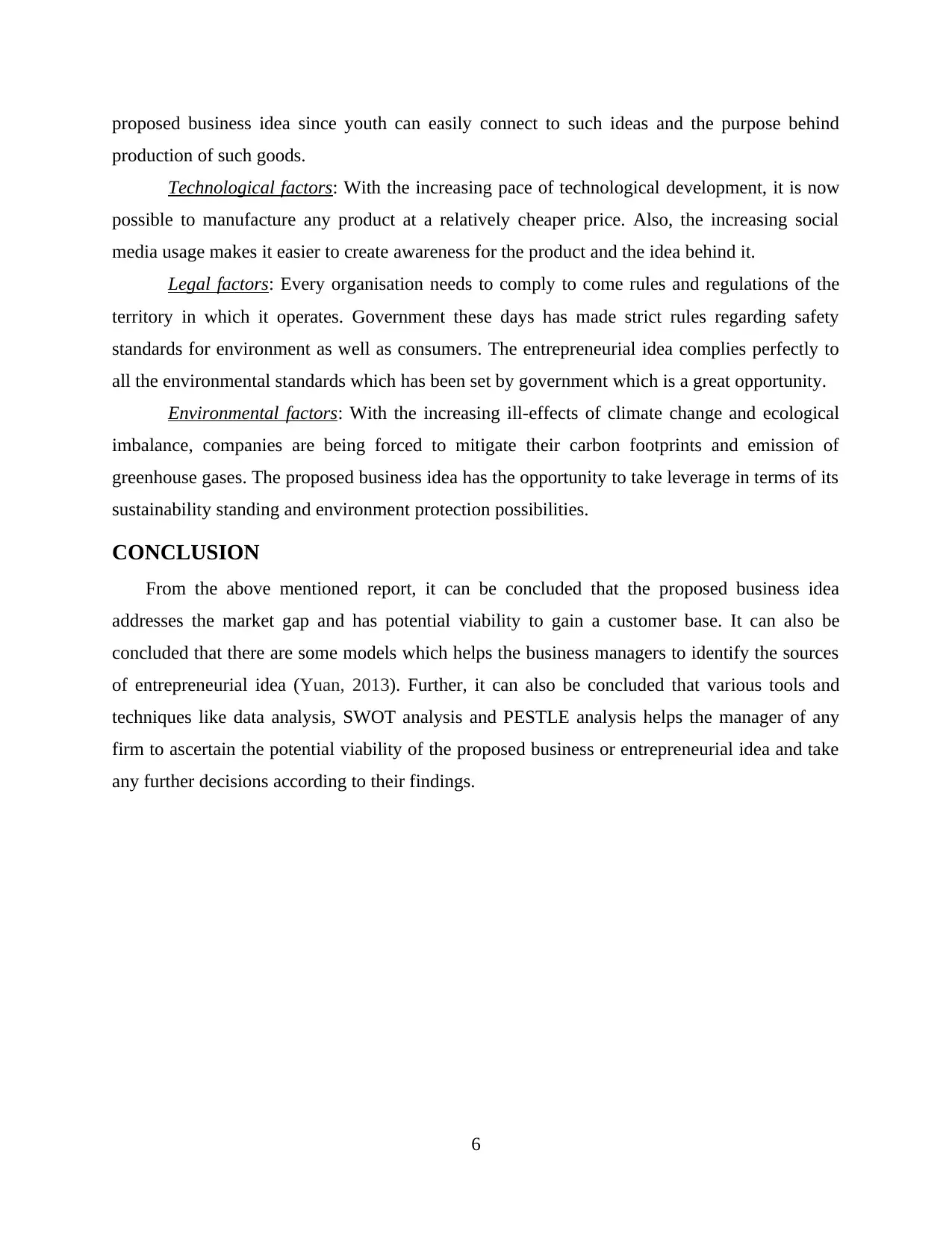
proposed business idea since youth can easily connect to such ideas and the purpose behind
production of such goods.
Technological factors: With the increasing pace of technological development, it is now
possible to manufacture any product at a relatively cheaper price. Also, the increasing social
media usage makes it easier to create awareness for the product and the idea behind it.
Legal factors: Every organisation needs to comply to come rules and regulations of the
territory in which it operates. Government these days has made strict rules regarding safety
standards for environment as well as consumers. The entrepreneurial idea complies perfectly to
all the environmental standards which has been set by government which is a great opportunity.
Environmental factors: With the increasing ill-effects of climate change and ecological
imbalance, companies are being forced to mitigate their carbon footprints and emission of
greenhouse gases. The proposed business idea has the opportunity to take leverage in terms of its
sustainability standing and environment protection possibilities.
CONCLUSION
From the above mentioned report, it can be concluded that the proposed business idea
addresses the market gap and has potential viability to gain a customer base. It can also be
concluded that there are some models which helps the business managers to identify the sources
of entrepreneurial idea (Yuan, 2013). Further, it can also be concluded that various tools and
techniques like data analysis, SWOT analysis and PESTLE analysis helps the manager of any
firm to ascertain the potential viability of the proposed business or entrepreneurial idea and take
any further decisions according to their findings.
6
production of such goods.
Technological factors: With the increasing pace of technological development, it is now
possible to manufacture any product at a relatively cheaper price. Also, the increasing social
media usage makes it easier to create awareness for the product and the idea behind it.
Legal factors: Every organisation needs to comply to come rules and regulations of the
territory in which it operates. Government these days has made strict rules regarding safety
standards for environment as well as consumers. The entrepreneurial idea complies perfectly to
all the environmental standards which has been set by government which is a great opportunity.
Environmental factors: With the increasing ill-effects of climate change and ecological
imbalance, companies are being forced to mitigate their carbon footprints and emission of
greenhouse gases. The proposed business idea has the opportunity to take leverage in terms of its
sustainability standing and environment protection possibilities.
CONCLUSION
From the above mentioned report, it can be concluded that the proposed business idea
addresses the market gap and has potential viability to gain a customer base. It can also be
concluded that there are some models which helps the business managers to identify the sources
of entrepreneurial idea (Yuan, 2013). Further, it can also be concluded that various tools and
techniques like data analysis, SWOT analysis and PESTLE analysis helps the manager of any
firm to ascertain the potential viability of the proposed business or entrepreneurial idea and take
any further decisions according to their findings.
6
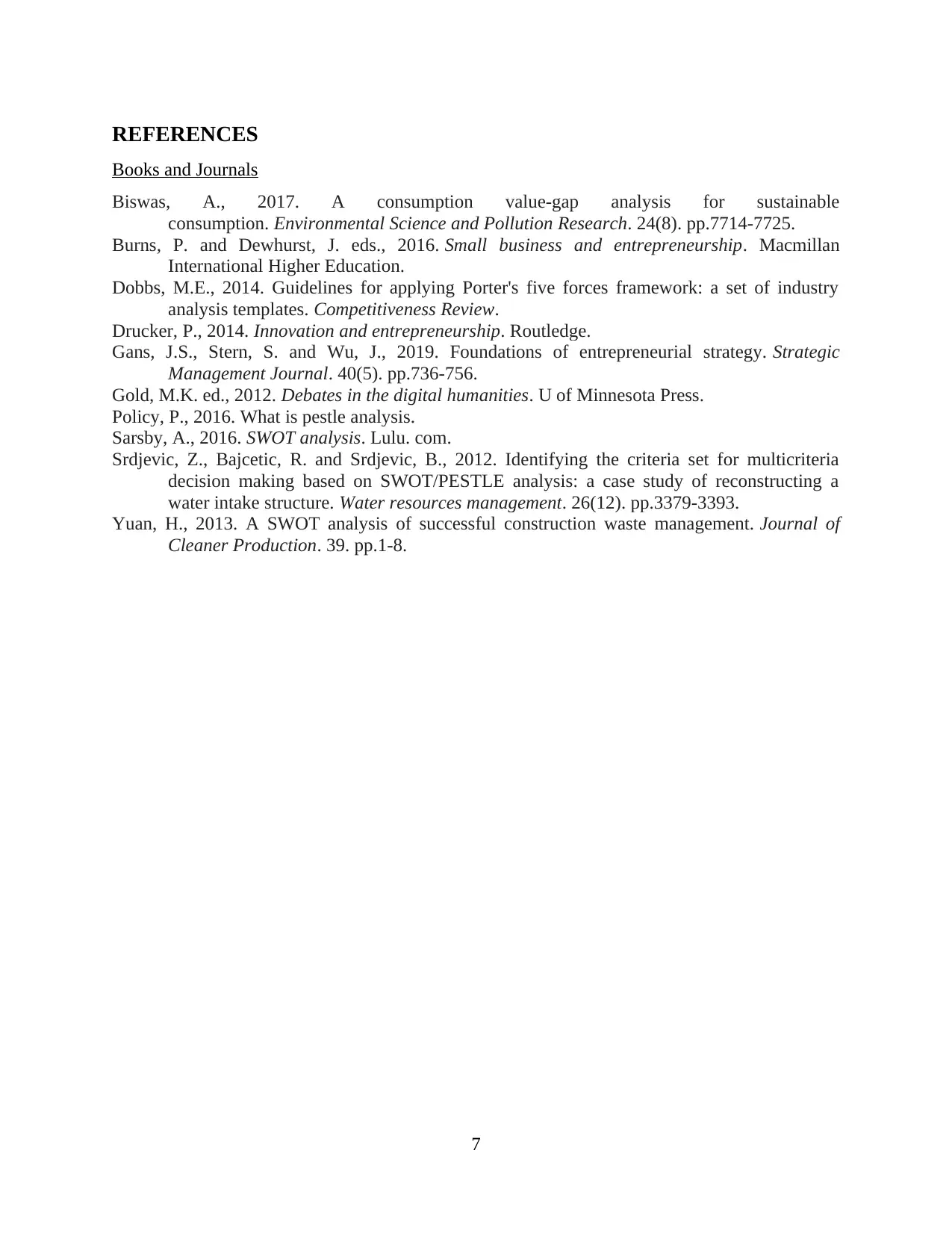
REFERENCES
Books and Journals
Biswas, A., 2017. A consumption value-gap analysis for sustainable
consumption. Environmental Science and Pollution Research. 24(8). pp.7714-7725.
Burns, P. and Dewhurst, J. eds., 2016. Small business and entrepreneurship. Macmillan
International Higher Education.
Dobbs, M.E., 2014. Guidelines for applying Porter's five forces framework: a set of industry
analysis templates. Competitiveness Review.
Drucker, P., 2014. Innovation and entrepreneurship. Routledge.
Gans, J.S., Stern, S. and Wu, J., 2019. Foundations of entrepreneurial strategy. Strategic
Management Journal. 40(5). pp.736-756.
Gold, M.K. ed., 2012. Debates in the digital humanities. U of Minnesota Press.
Policy, P., 2016. What is pestle analysis.
Sarsby, A., 2016. SWOT analysis. Lulu. com.
Srdjevic, Z., Bajcetic, R. and Srdjevic, B., 2012. Identifying the criteria set for multicriteria
decision making based on SWOT/PESTLE analysis: a case study of reconstructing a
water intake structure. Water resources management. 26(12). pp.3379-3393.
Yuan, H., 2013. A SWOT analysis of successful construction waste management. Journal of
Cleaner Production. 39. pp.1-8.
7
Books and Journals
Biswas, A., 2017. A consumption value-gap analysis for sustainable
consumption. Environmental Science and Pollution Research. 24(8). pp.7714-7725.
Burns, P. and Dewhurst, J. eds., 2016. Small business and entrepreneurship. Macmillan
International Higher Education.
Dobbs, M.E., 2014. Guidelines for applying Porter's five forces framework: a set of industry
analysis templates. Competitiveness Review.
Drucker, P., 2014. Innovation and entrepreneurship. Routledge.
Gans, J.S., Stern, S. and Wu, J., 2019. Foundations of entrepreneurial strategy. Strategic
Management Journal. 40(5). pp.736-756.
Gold, M.K. ed., 2012. Debates in the digital humanities. U of Minnesota Press.
Policy, P., 2016. What is pestle analysis.
Sarsby, A., 2016. SWOT analysis. Lulu. com.
Srdjevic, Z., Bajcetic, R. and Srdjevic, B., 2012. Identifying the criteria set for multicriteria
decision making based on SWOT/PESTLE analysis: a case study of reconstructing a
water intake structure. Water resources management. 26(12). pp.3379-3393.
Yuan, H., 2013. A SWOT analysis of successful construction waste management. Journal of
Cleaner Production. 39. pp.1-8.
7
⊘ This is a preview!⊘
Do you want full access?
Subscribe today to unlock all pages.

Trusted by 1+ million students worldwide
1 out of 9
Related Documents
Your All-in-One AI-Powered Toolkit for Academic Success.
+13062052269
info@desklib.com
Available 24*7 on WhatsApp / Email
![[object Object]](/_next/static/media/star-bottom.7253800d.svg)
Unlock your academic potential
Copyright © 2020–2025 A2Z Services. All Rights Reserved. Developed and managed by ZUCOL.





